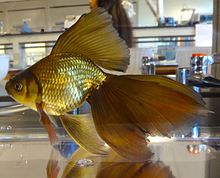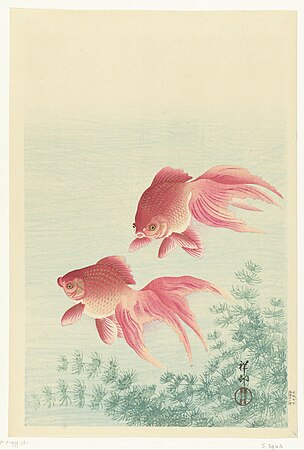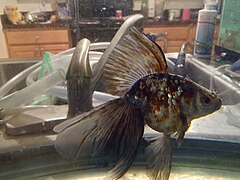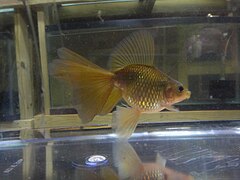Veiltail
- View a machine-translated version of the German article.
- Machine translation, like DeepL or Google Translate, is a useful starting point for translations, but translators must revise errors as necessary and confirm that the translation is accurate, rather than simply copy-pasting machine-translated text into the English Wikipedia.
- Consider adding a topic to this template: there are already 9,155 articles in the main category, and specifying
|topic=will aid in categorization. - Do not translate text that appears unreliable or low-quality. If possible, verify the text with references provided in the foreign-language article.
- You must provide copyright attribution in the edit summary accompanying your translation by providing an interlanguage link to the source of your translation. A model attribution edit summary is
Content in this edit is translated from the existing German Wikipedia article at [[:de:Schleierschwanz]]; see its history for attribution. - You may also add the template
{{Translated|de|Schleierschwanz}}to the talk page. - For more guidance, see Wikipedia:Translation.
 | |
| Country of origin | United States |
|---|---|
| Type | Veiltailed |
| Classification | |
| BAS | [1] |
The veiltail is a type of goldfish known for its extra-long, flowing double tail and high sail-like dorsal fin.[1][2]
Description
The veiltail has a modified deep-and-round ryukin-shaped body, though without the dorsal 'hump' characteristic of ryukins. The hallmark of the breed is its lengthy and graceful double tail which is square-edged and without any forking or indentation between the lobes.
It also has a high, prominent and well-developed dorsal fin. The anal fins are paired and are quite well developed as well. The term 'veiltail' is commonly and erroneously applied to any goldfish displaying a long caudal, but true veiltails must have all the characteristics described above. Veiltails are available in many colors and may have either metallic or nacreous scales. They can grow from 8 to 12 inches (20 to 30 cm). They are not good swimmers but can be kept with other fancy goldfish. Veiltails will not accept temperatures below 55 °F (13 °C).[3]
History and origins
The veiltail, a name coined by William T. Innes, originated in the United States in the 1890s when Franklin Barrett of Philadelphia crossed a Japanese-bred fringetail ryukin to a telescope eye goldfish that exhibited a short, square-edged caudal. According to William Seale[4] this fringetail was one of many imported by the Wisconsin State Fish Commission for the World's Fair. However, these fish became sick with fungus and were not shown in the 1893 fair. Mr. Seale saved 5 or 6 of these fish and returned home to Philadelphia with them. Mr. Seale then sold one of these fish to Franklin Barrett for $15 and this was the fish Barrett used to cross to a short but square tailed telescope eye goldfish. The telescope eye goldfish used for this cross were obtained as imports by John Cugley of Philadelphia. This resulted in a strain of fish soon to be known throughout the world as Philadelphia veiltails.[1][2][5] Although some have suggested that Philadelphia Veiltails died out in America,[6] a man named Al Thomma was able to obtain stock from a John (Andy) W. Anderson of Philadelphia who possessed fish from the original Barrett line.[7] Mr. Anderson worked for Innes Publishing as advertising editor and publisher of The Aquarium Magazine. Through the work of Al Thomma and Al Foster.[8] The Philadelphia Veiltail still exists today.
-
 Drawing of Franklin Barrett's original Japanese fringetail, which was used to breed the veiltail
Drawing of Franklin Barrett's original Japanese fringetail, which was used to breed the veiltail -
 Two Veiltail Goldish, Japanese painting by Ohara Koson, 1900-1930
Two Veiltail Goldish, Japanese painting by Ohara Koson, 1900-1930
Variants
Apart from those bred and developed in the United States, there are now also Chinese and English strains. They can also occur with normal or telescope-eyes.[1][2]
-
 Chinese veiltail
Chinese veiltail - English veiltail
- English veiltail with metallic color
-
 Philadelphia veiltail
Philadelphia veiltail
Special care
The long and trailing tail of the veiltail is delicate and can be easily damaged. Veiltails are also susceptible to low water temperatures. Telescope-eyed veiltails have difficulty competing for food with more active goldfish.[1][2]
See also
- Goldfish
References
- ^ a b c d Andrews, Chris. An Interpet Guide to Fancy Goldfish, Interpet Publishing, 2002. - ISBN 1-902389-64-6
- ^ a b c d Johnson, Dr. Erik L., D.V.M. and Richard E. Hess. Fancy Goldfish: A Complete Guide to Care and Collecting, Weatherhill, Shambala Publications, Inc., 2006. - ISBN 0-8348-0448-4
- ^ Free Information Keeping Veiltail Goldfish
- ^ "The Aquarium" magazine. March 1968.
- ^ Aquarium Magazine, Goldfish Society of America, March 1968, p. 55.
- ^ "Spike's Goldfish Guide" by Peter J. Ponzio. Mid-Atlantic Koi Club. 2007
- ^ "The Goldfish Report" of the Goldfish Society of America March/April 2003.
- ^ "The Goldfish Report" of the Goldfish Society of America July/August 2004
- v
- t
- e
- Bubble Eye
- Butterfly tail
- Celestial Eye
- Comet
- Common
- Curled-gill goldfish
- Eggfish
- Fantail
- Izumo Nankin
- Jikin
- Lionhead
- Meteor
- Oranda
- Pearlscale
- Pompom
- Ranchu
- Ryukin
- Shubunkin
- Tamasaba
- Telescope eye
- Tosakin
- Veiltail
- Wakin
















